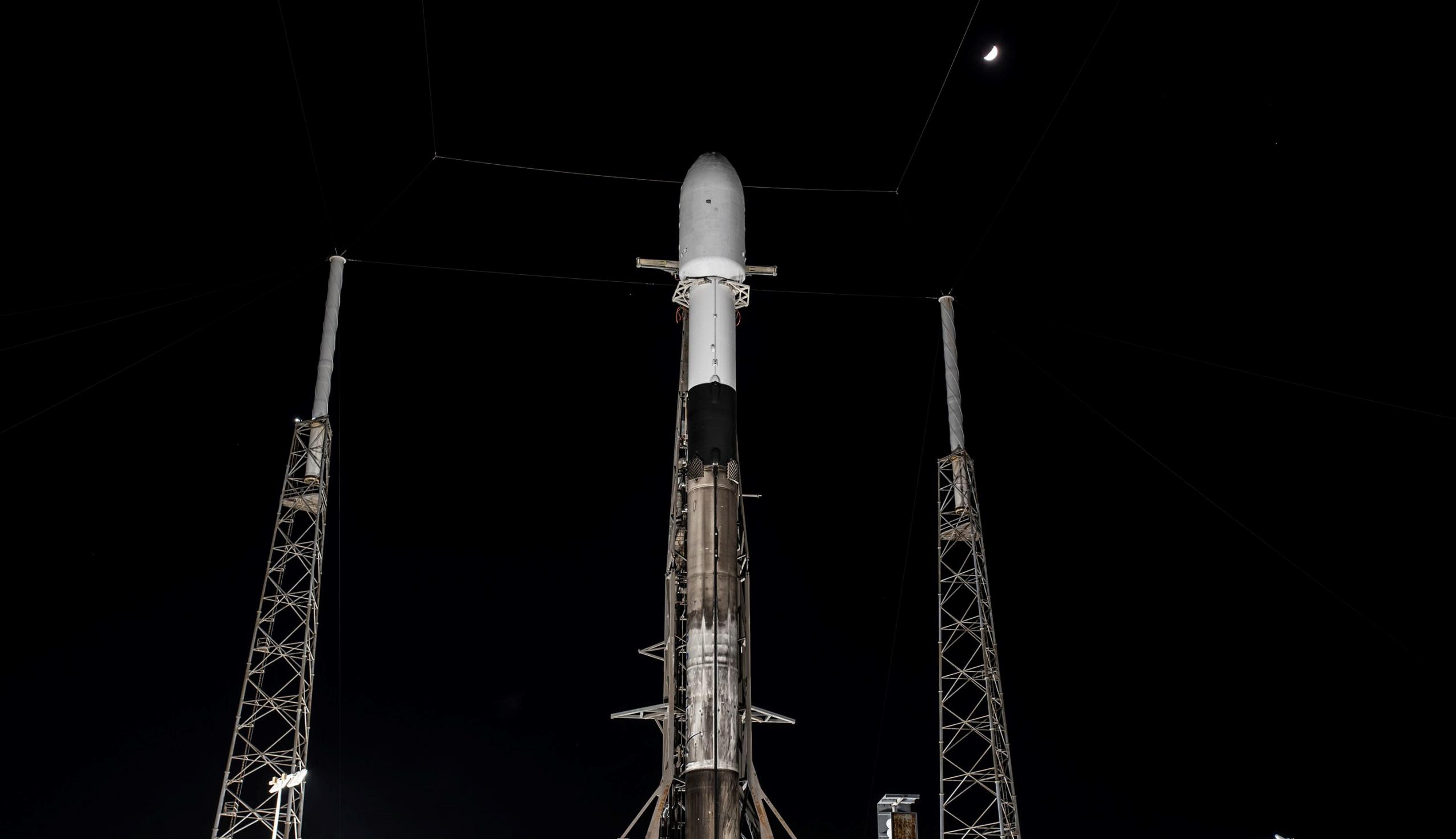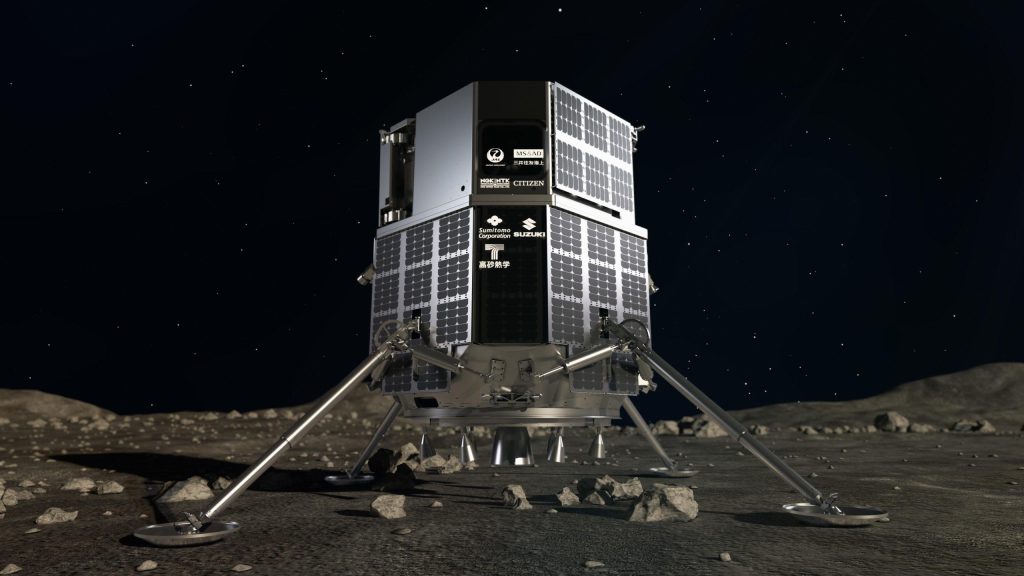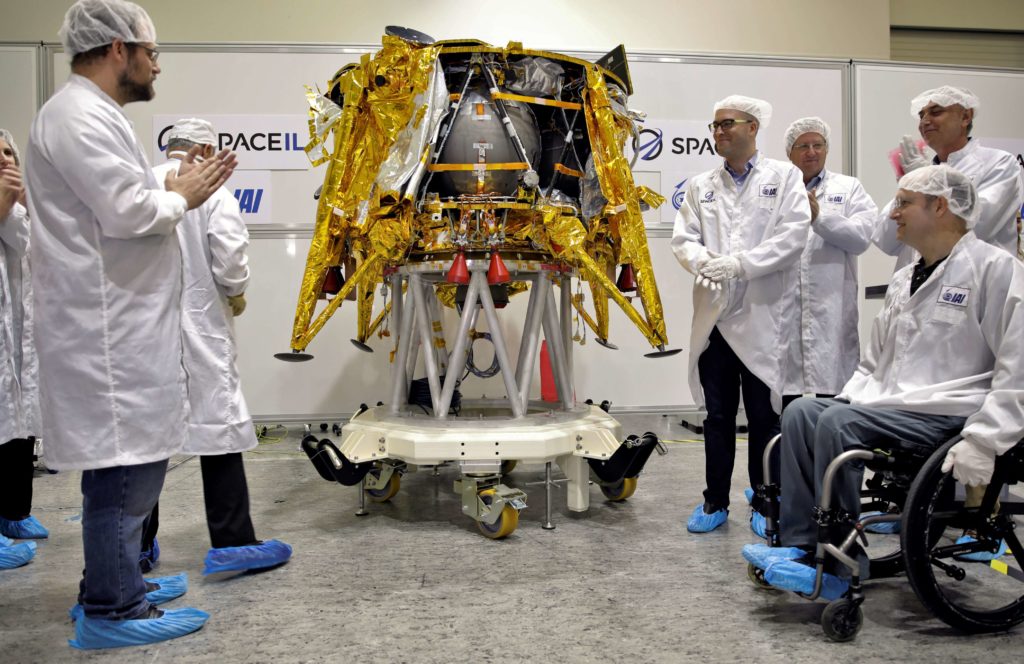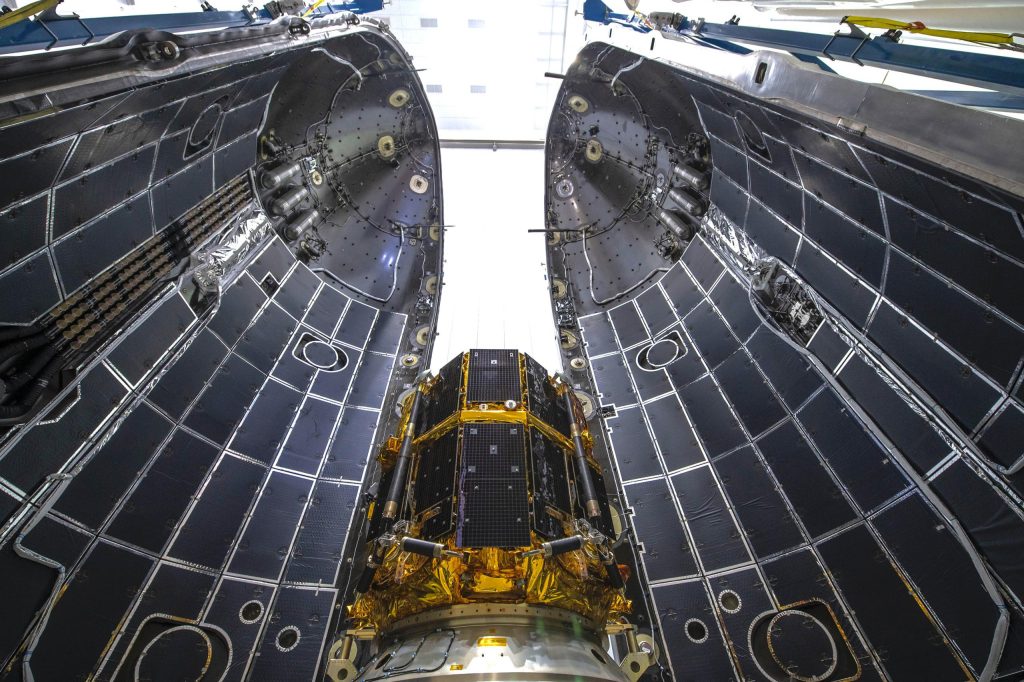

News
SpaceX’s Japanese Moon lander launch back on the calendar after indefinite delay
Update: After indefinitely delaying ispace’s first Moon lander launch on November 30th to fix unspecified issues with its Falcon 9 rocket, multiple sources indicate that SpaceX has put the mission back on its calendar.
Barring additional issues, the private HAKUTO-R Moon lander is now scheduled to lift off from SpaceX’s Cape Canaveral Space Force Station (CCSFS) LC-40 pad no earlier than (NET) 3:04 am EST (08:04 UTC) on Wednesday, December 7th. The mission’s quick return after just a few days of rework is a good sign that the issue that forced SpaceX to stand down was relatively minor. Simultaneously, SpaceX is moving ahead with plans to launch its first mission for OneWeb – a low Earth orbit satellite Internet provider competing directly with Starlink – less than ten hours prior, at 5:37 pm EST (22:37 UTC) on December 6th.
SpaceX support ship Doug departed Florida’s Port Canaveral on the afternoon of December 4th, likely en route to recover Falcon 9’s payload fairing after its first OneWeb launch. If SpaceX is, in fact, working towards a December 7th launch of HAKUTO-R, twin support ship Bob will likely also head to sea within the next 24 hours.

SpaceX has delayed the launch of Japanese startup ispace’s first Moon lander, HAKUTO-R, from Wednesday to Thursday, December 1st “to allow for additional pre-flight checkouts.”
The mission will be the third Moon launch from US soil in less than four months after SpaceX’s successful launch of the South Korean Pathfinder Lunar Orbiter (KPLO) in August and the debut of NASA’s Space Launch System (SLS) rocket earlier this month. Perhaps more importantly, ispace has the opportunity to become the first company in history to successfully land a privately-developed spacecraft on the Moon, a milestone that would arguably mark the start of a new era of lunar exploration.
The update that's rolling out to the fleet makes full use of the front and rear steering travel to minimize turning circle. In this case a reduction of 1.6 feet just over the air— Wes (@wmorrill3) April 16, 2024
ispace’s first HAKUTO-R Moon lander is expected to weigh approximately 1050 kilograms (~2300 lb) at liftoff and is designed to land up to 30 kilograms (~66 lb) of cargo on the lunar surface. The lander is made by several commercial partners: ispace has provided most of its design and structures, but Europe’s ArianeGroup supplied all of HAKUTO-R’s engines, plumbing, and propulsion hardware and was responsible for most of the final assembly process.
Because of ArianeGroup’s involvement, it’s likely that HAKUTO-R shares direct heritage with the European Service Module currently powering NASA’s Orion spacecraft on its first mission to the Moon. It also arguably makes the mission more of a collaboration between Europe and Japan than an exclusively Japanese mission, though HAKUTO-R will still technically be Japan’s first private mission to the Moon.
If successful, it could also become the first privately-funded Moon landing in history. But HAKUTO-R can’t claim to be the first private Moon landing attempt, a title held by Israeli company SpaceIL’s ill-fated Beresheet Moon lander. Launched by SpaceX as a rideshare passenger sitting on top of an Indonesian communications satellite, Beresheet propelled itself all the way from geostationary transfer orbit to lunar orbit over the course of about six weeks. Just a minute or so before touchdown, a manual command inadvertently shut down the spacecraft’s propulsion, causing it to impact the surface of the Moon at ~500 kilometers per hour (310 mph) – less than 8% away from a soft landing.
In September 2019, just five months later, India’s first nationally developed Moon lander got even closer to a successful landing, losing control at a velocity of just 210 km/h (~130 mph) and an altitude of 330 meters (1080 ft). Since the Soviet Union’s 1976 Luna-26 mission, only China’s national space agency (CNSA) has successfully landed on the Moon, completing three landings between 2013 and 2020. The last successful Western Moon landing (Apollo 17; also the last crewed Moon landing) occurred in 1972.


ispace’s ultimate goal is to help facilitate the creation of infrastructure capable of supporting a permanent population of 1000 people on the Moon by 2040. The Japanese startup has privately raised $210 million since it was founded in 2010. In 2022, it won a $73M NASA contract to develop a much larger SERIES-2 vehicle capable of sending either “500 kilograms to the [lunar] surface or as much as 2000 kilograms to lunar orbit.” SERIES-2 will be developed out of ispace’s US branch instead of its Japanese headquarters.
HAKUTO-R will carry seven payloads:
- A solid-state battery for ispace corporate partner NGK SPARK PLUG CO
- A Moon rover (Rashid) for the United Arab Emirates space agency
- JAXA’s transformable lunar robot
- A Canadian Space Agency flight computer prototype
- A camera system built by Canda’s Canadensys
- A panel engraved with the names of HAKUTO’s crowdfunding supporters
- A music disc containing Japanese rock band Sakanaction’s song “SORATO”
In addition to HAKUTO-R, SpaceX’s Falcon 9 rocket will simultaneously launch the NASA Jet Propulsion Laboratory’s (JPL) Lunar Flashflight ice surveyor as a rideshare payload. After launch, Lunar Flashlight will attempt to enter an elliptical lunar orbit and use an infrared laser to (invisibly) illuminate the surface of craters that have been in shadow for millions of years. The way the surface reflects that laser light will allow the spacecraft to prospect for water ice deposits that could one day be mined and converted into rocket propellant.
Tune in below around 3:20 am EST (08:25 UTC) on Thursday, December 1st to watch SpaceX launch Japan’s first privately-developed Moon lander.
News
SpaceX’s Crew-11 mission targets July 31 launch amid tight ISS schedule
The flight will lift off from Launch Complex 39A at Kennedy Space Center in Florida.

NASA and SpaceX are targeting July 31 for the launch of Crew-11, the next crewed mission to the International Space Station (ISS). The flight will lift off from Launch Complex 39A at Kennedy Space Center in Florida, using the Crew Dragon Endeavour and a Falcon 9 booster.
Crew Dragon Endeavour returns
Crew-11 will be the sixth flight for Endeavour, making it SpaceX’s most experienced crew vehicle to date. According to SpaceX’s director of Dragon mission management, Sarah Walker, Endeavour has already carried 18 astronauts representing eight countries since its first mission with NASA’s Bob Behnken and Doug Hurley in 2020, as noted in an MSN report.
“This Dragon spacecraft has successfully flown 18 crew members representing eight countries to space already, starting with (NASA astronauts) Bob (Behnken) and Doug (Hurley) in 2020, when it returned human spaceflight capabilities to the United States for the first time since the shuttle retired in July of 2011,” Walker said.
For this mission, Endeavour will debut SpaceX’s upgraded drogue 3.1 parachutes, designed to further enhance reentry safety. The parachutes are part of SpaceX’s ongoing improvements to its human-rated spacecraft, and Crew-11 will serve as their first operational test.
The Falcon 9 booster supporting this launch is core B1094, which has launched in two previous Starlink missions, as well as the private Ax-4 mission on June 25, as noted in a Space.com report.
The four-members of Crew-11 are NASA astronauts Zena Cardman and Mike Fincke, as well as Japan’s Kimiya Yui and Russia’s Oleg Platonov.
Tight launch timing
Crew-11 is slated to arrive at the ISS just as NASA coordinates a sequence of missions, including the departure of Crew-10 and the arrival of SpaceX’s CRS-33 mission. NASA’s Bill Spetch emphasized the need for careful planning amid limited launch resources, noting the importance of maintaining station altitude and resupply cadence.
“Providing multiple methods for us to maintain the station altitude is critically important as we continue to operate and get the most use out of our limited launch resources that we do have. We’re really looking forward to demonstrating that capability with (CRS-33) showing up after we get through the Crew-11 and Crew-10 handover,” Spetch stated.
Lifestyle
EV fans urge Tesla to acquire Unplugged Performance for edge in fleet and security industry
Unplugged Performance has built a name for itself by producing performance upgrades for Tesla vehicles.

A growing number of Tesla enthusiasts and longtime community voices are calling on the electric vehicle maker to acquire Unplugged Performance, a California-based aftermarket company best known for tuning Tesla vehicles and developing specialized government fleet solutions under its UP.FIT division.
The idea was once considered a niche proposal among EV fans, but it is now gaining serious attention not just as a performance play but as a strategic move to deepen Tesla’s roots in the fleet and security industry.
A strategic fit
Unplugged Performance has built a name for itself by producing performance upgrades for Tesla vehicles, from track-optimized components to visual and aerodynamic upgrades. But in recent years, its UP.FIT division has pivoted toward a more functional future by outfitting Tesla vehicles like Model Ys for police, military, and government use.
That work has sparked growing calls for closer collaboration with Tesla, especially as the EV maker increasingly leans into autonomy, AI, and fleet services as core components of its next chapter.
“I posted this four years ago, but I think it’s more true now than ever,” wrote Whole Mars Catalog, a well-known Tesla investor and FSD Beta tester, on X. “Tesla should buy Unplugged. But not just as a Performance division. What they are doing with UP.FIT unlocks large government and commercial fleet purchases that can improve utilization.”
Tesla fans such as shareholder Sawyer Merritt echoed the sentiment, calling Unplugged a “great fit within Tesla.” adding, “They are literally located directly next to Tesla’s design studio in Hawthorne.”
Enabling the next wave
Supporters of the idea noted that integrating Unplugged into Tesla’s corporate structure could help accelerate the adoption of autonomous technologies in government sectors. With UP.FIT patrol cars already in use across some U.S. police departments, Tesla fans envisioned a future where self-driving Teslas could potentially revolutionize law enforcement, search-and-rescue, and public service logistics.
“Just imagine how autonomous patrol cars could transform policing and bring us into a safer future,” the veteran FSD tester wrote.
The benefits could also extend to Tesla’s existing consumer base. “They also have some incredible products in the works that I think will appeal to many ordinary Tesla drivers — not just those looking for performance or mods. Stuff that’s so good it should have come straight from the design studio next door,” Whole Mars Catalog noted.
Unplugged Performance, founded in 2013, shares not just a product vision with Tesla, but also geography. Its Hawthorne headquarters sits directly adjacent to Tesla’s design studio, and the two companies have maintained a close working relationship over the years. The aftermarket firm has long positioned itself as a “mission-aligned” partner to Tesla.
In response to the recent calls for acquisition, Unplugged Performance acknowledged the support from the community. “Our very existence is to support the Tesla mission with @UpfitTesla and @UnpluggedTesla,” Unplugged CEO Ben Schaffer posted on X. “We love working with Tesla and are grateful for the community’s support since 2013!”
News
Tesla debuts hands-free Grok AI with update 2025.26: What you need to know
All new Tesla vehicles delivered on or after July 12, 2025, will include Grok AI out of the box

Tesla has begun rolling out Grok, an in-car conversational AI assistant developed by xAI, to eligible vehicles starting July 12. The feature marks the most direct integration yet between Elon Musk’s artificial intelligence startup and Tesla’s consumer product lineup, offering drivers hands-free access to a chat-style companion while on the road.
Grok comes pre-installed on new vehicles
According to Tesla’s FAQ page for the feature, all new vehicles delivered on or after July 12, 2025, will include Grok AI out of the box. Owners of older vehicles may gain access through an over-the-air update, provided their vehicle meets a few hardware and software requirements.
Specifically, Grok is currently only supported on Tesla models equipped with an AMD infotainment processor and running vehicle software version 2025.26 and higher. Compatible models include the Model S, Model 3, Model X, Model Y, and Cybertruck. A Premium Connectivity subscription or active Wi-Fi connection is also required.
Tesla notes that additional vehicle compatibility may arrive in future software updates.
Grok’s features and limitations for now
Drivers can engage with Grok using the App Launcher or by pressing and holding the voice command button on the steering wheel. Grok is designed to answer questions and hold conversations using natural language, offering responses tailored to its chosen personality—ranging from “Storyteller” to the more eccentric “Unhinged.”
For fun, Tesla posted a demonstration of Grok likely running on “Unhinged” talking about what it would do to Optimus when they are on a date, much to the shock of the humanoid robot’s official social media account.
It should be noted, however, that Grok cannot currently issue commands to the vehicle itself, at least for now. Traditional voice commands for tasks like climate control, navigation, or media remain separate from Grok as of writing.
The feature is being released in Beta and does not require a Grok account or xAI subscription to activate, although that policy may change over time.
Grok privacy and in-car experience
Tesla emphasizes that interactions with Grok are securely processed by xAI and not linked to a user’s Tesla account or vehicle. Conversations remain anonymous unless a user signs into Grok separately to sync their history across devices.
Tesla has also begun promoting Grok directly on its official vehicle webpages, showcasing the feature as part of its in-car experience, further highlighting the company’s increasing focus on AI and infotainment features on its all-electric vehicles.
-

 Elon Musk2 weeks ago
Elon Musk2 weeks agoTesla investors will be shocked by Jim Cramer’s latest assessment
-

 Elon Musk3 days ago
Elon Musk3 days agoxAI launches Grok 4 with new $300/month SuperGrok Heavy subscription
-

 Elon Musk5 days ago
Elon Musk5 days agoElon Musk confirms Grok 4 launch on July 9 with livestream event
-

 News1 week ago
News1 week agoTesla Model 3 ranks as the safest new car in Europe for 2025, per Euro NCAP tests
-

 Elon Musk1 week ago
Elon Musk1 week agoxAI’s Memphis data center receives air permit despite community criticism
-

 News2 weeks ago
News2 weeks agoXiaomi CEO congratulates Tesla on first FSD delivery: “We have to continue learning!”
-

 News2 weeks ago
News2 weeks agoTesla sees explosive sales growth in UK, Spain, and Netherlands in June
-

 Elon Musk2 weeks ago
Elon Musk2 weeks agoTesla scrambles after Musk sidekick exit, CEO takes over sales
















